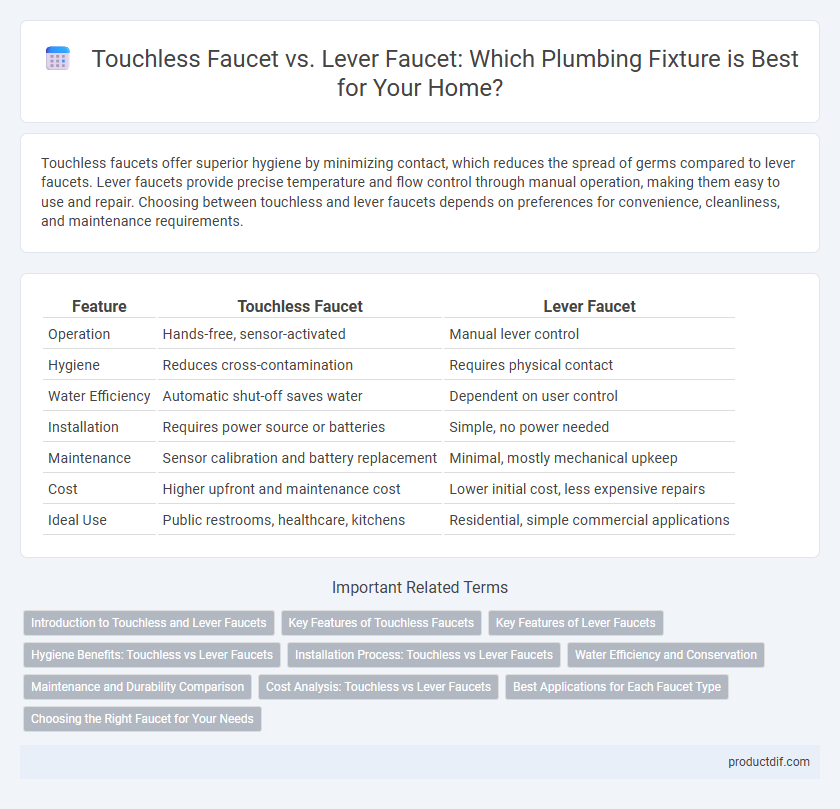Touchless faucets offer superior hygiene by minimizing contact, which reduces the spread of germs compared to lever faucets. Lever faucets provide precise temperature and flow control through manual operation, making them easy to use and repair. Choosing between touchless and lever faucets depends on preferences for convenience, cleanliness, and maintenance requirements.
Table of Comparison
| Feature | Touchless Faucet | Lever Faucet |
|---|---|---|
| Operation | Hands-free, sensor-activated | Manual lever control |
| Hygiene | Reduces cross-contamination | Requires physical contact |
| Water Efficiency | Automatic shut-off saves water | Dependent on user control |
| Installation | Requires power source or batteries | Simple, no power needed |
| Maintenance | Sensor calibration and battery replacement | Minimal, mostly mechanical upkeep |
| Cost | Higher upfront and maintenance cost | Lower initial cost, less expensive repairs |
| Ideal Use | Public restrooms, healthcare, kitchens | Residential, simple commercial applications |
Introduction to Touchless and Lever Faucets
Touchless faucets use infrared sensors to detect hand movements, providing a hygienic, water-saving solution by automatically controlling water flow. Lever faucets operate with a manual handle that adjusts water temperature and pressure, offering reliable and straightforward functionality. Both types are essential in modern plumbing, catering to different user preferences and hygiene standards.
Key Features of Touchless Faucets
Touchless faucets use infrared sensors to detect hand movements, enabling water flow without physical contact, which enhances hygiene by reducing the spread of germs. These faucets typically come with adjustable sensor ranges and automatic shutoff features to prevent water wastage and promote eco-friendly usage. Their modern design and easy-to-clean surfaces offer greater convenience and are ideal for both residential and commercial plumbing fixtures.
Key Features of Lever Faucets
Lever faucets offer precise manual control with a single handle that adjusts both water temperature and flow, providing ergonomic ease for all users. Designed with durable materials like brass or stainless steel, these faucets ensure long-lasting performance and resistance to corrosion. Their straightforward installation and maintenance make lever faucets a practical choice for both residential and commercial plumbing fixtures.
Hygiene Benefits: Touchless vs Lever Faucets
Touchless faucets significantly reduce the spread of germs by eliminating the need to touch handles, making them ideal for maintaining high hygiene standards in kitchens and bathrooms. Lever faucets, while easier to operate than traditional knobs, still require physical contact, which can transfer bacteria and viruses. Installing touchless faucets in high-traffic areas enhances sanitation by minimizing cross-contamination and promoting a cleaner environment.
Installation Process: Touchless vs Lever Faucets
Touchless faucets require electrical wiring or batteries for sensor activation, often involving more complex installation steps compared to lever faucets. Lever faucets typically feature straightforward plumbing connections with minimal tools needed, making them easier and faster to install. Professional installation is recommended for touchless faucets to ensure proper sensor calibration and avoid water leaks.
Water Efficiency and Conservation
Touchless faucets use infrared sensors to activate water flow only when hands are detected, significantly reducing water wastage compared to lever faucets, which can be left running unintentionally. Studies show touchless faucets can save up to 30% more water by minimizing unnecessary flow and promoting efficient usage. Lever faucets provide manual control but often result in higher water consumption due to continuous flow during adjustment and forgetfulness.
Maintenance and Durability Comparison
Touchless faucets typically require less frequent cleaning and maintenance due to their sensor technology reducing contact and buildup of grime, which enhances long-term durability. Lever faucets, while mechanically simpler and easier to repair, often experience wear and tear from physical use, leading to more frequent maintenance. Sensor components in touchless faucets can be more costly to replace but generally extend the fixture's lifespan by minimizing mechanical wear.
Cost Analysis: Touchless vs Lever Faucets
Touchless faucets typically have higher upfront costs, ranging from $150 to $400, compared to lever faucets, which generally cost between $50 and $150. Maintenance expenses for touchless faucets can also increase due to sensor calibration and battery replacements, while lever faucets require minimal upkeep. Long-term energy savings with touchless models may offset initial investments, especially in commercial or high-usage environments.
Best Applications for Each Faucet Type
Touchless faucets excel in high-traffic public restrooms and healthcare facilities where hygiene and minimizing contamination are critical, offering hands-free operation that reduces the spread of germs. Lever faucets are best suited for residential kitchens and bathrooms, providing precise control and ease of use, especially for individuals with limited dexterity. Choosing the right faucet depends on the setting's demand for sanitation, user accessibility, and frequency of use.
Choosing the Right Faucet for Your Needs
Selecting the right faucet depends on your priorities for hygiene, convenience, and control. Touchless faucets use infrared sensors to activate water flow, minimizing contact and reducing germ transmission, ideal for high-traffic or healthcare settings. Lever faucets provide precise manual control over water temperature and pressure, making them suitable for traditional kitchens and bathrooms where tactile feedback is preferred.
Touchless Faucet vs Lever Faucet Infographic

 productdif.com
productdif.com